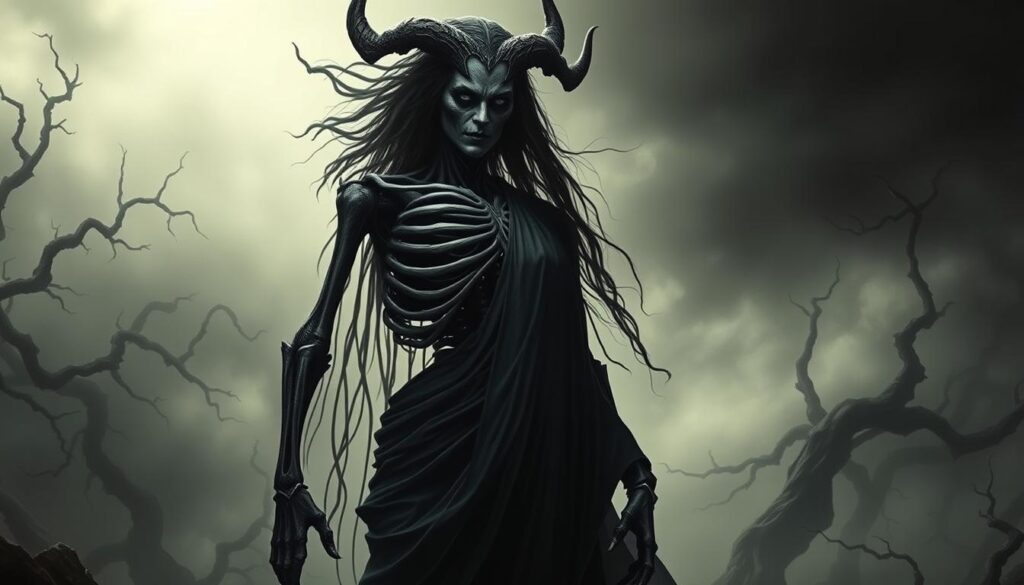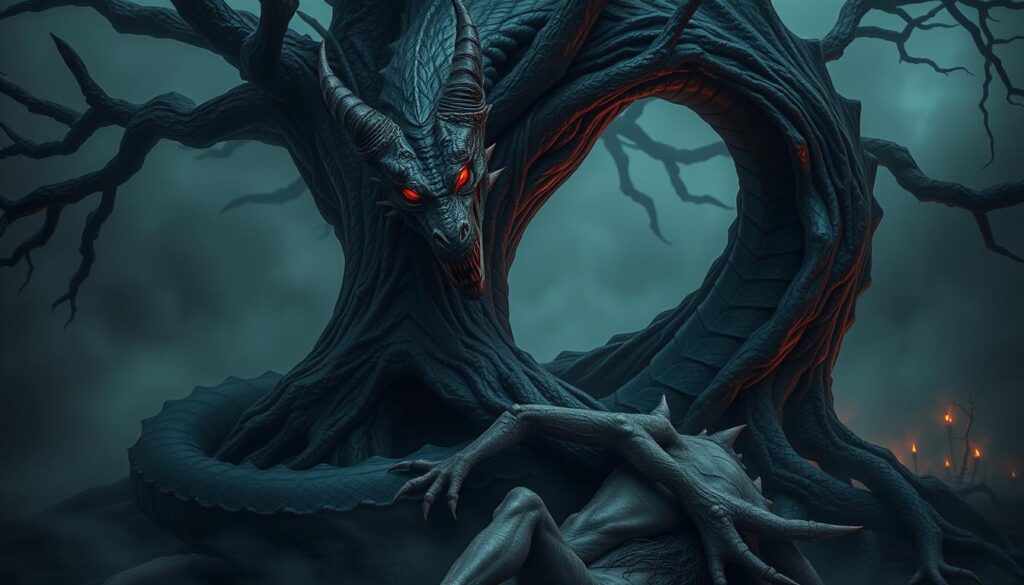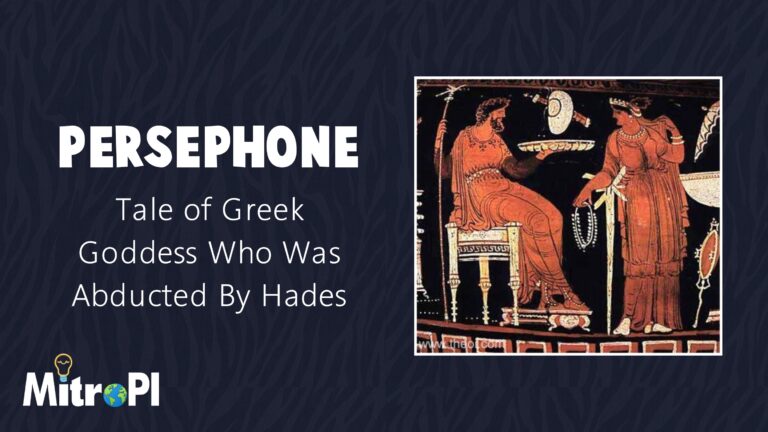Norse gods and creatures have long fascinated storytellers and scholars. A few stand out as the most terrifying. They include the monstrous wolf Fenrir and the colossal World Serpent Jörmungandr. Norse mythology’s dark side is filled with fear, destruction, and the eternal battle between good and evil.

These fearsome beings were born from the Nordic cosmos’s primal forces. They have deeply influenced Viking beliefs and culture. Their stories, passed down through generations, still captivate people around the world. They offer a glimpse into the complex and unsettling world of Norse mythology.
Key Takeaways
- The Norse mythology is filled with terrifying figures that have shaped the beliefs and culture of Scandinavia.
- These entities, such as Fenrir, Jörmungandr, and Hel, are born from the primal forces of the Nordic cosmos.
- The stories of these fearsome beings have captured the imagination of storytellers and scholars alike, and continue to fascinate audiences worldwide.
- The dark side of Norse mythology explores the eternal struggle between good and evil, and the sense of dread and unease these figures evoke.
- Understanding the origins and roles of these terrifying figures is crucial to fully appreciating the depth and complexity of Nordic legends.
Understanding the Dark Side of Norse Mythology
Norse cosmology is a world filled with mythological beings that fascinate many. At its center is Yggdrasil, the ancient tree of life. It connects to the different realms of the Norse pantheon.
Origins of Norse Mythological Beings
The stories of these beings come from the Poetic Edda and the Prose Edda. These ancient texts give us a glimpse into Viking Age culture and beliefs. They tell of creatures like Fenrir and the Norns, showing the Norse people’s fears and respect for nature.
The Role of Fear in Nordic Tales
Fear was key in Norse myths. The Vikings lived in a harsh climate with many dangers. This fear led to the creation of powerful, scary beings that controlled nature and life and death.
These stories helped the Norse people understand the unknown. They wanted to control the unpredictable forces of their lives.
“The Norse myths are not just stories of gods and heroes, but a reflection of the harsh realities of life in the North. They speak to our deepest fears and greatest desires, reminding us of our own fragility and the power of the natural world.”
Fenrir: The Monstrous Wolf Who Devours the Sun
In Norse mythology, Fenrir is a figure of awe and terror. He is destined to eat the sun during Ragnarök, the end of the world. Fenrir is Loki’s son, born in darkness and foreboding.
The gods feared Fenrir’s power and the destruction he would cause. They bound him with Gleipnir, a magical rope made from rare things. Only Tyr, with one hand, could put his hand in Fenrir’s mouth as a promise.
“Fenrir, the monstrous wolf, shall break free and devour the sun, plunging the world into darkness.”
Fenrir’s bonds will eventually break, and he will unleash chaos. This is part of Ragnarök’s prophecy. It shows the dark forces in Norse mythology.
Fenrir’s story teaches us about fear and trying to control the uncontrollable. As Ragnarök approaches, Fenrir remains a haunting figure in Norse mythology.
Jörmungandr: The World Serpent that Encircles Midgard
In Norse mythology, Jörmungandr is a creature that inspires both fear and awe. This massive Midgard Serpent wraps around the world. It is also known as Thor’s nemesis. Jörmungandr plays a key role in Nordic legends, showing the balance between order and chaos in the Norse cosmology.
The Serpent’s Impact on Viking Culture
The Vikings were deeply fascinated by Jörmungandr. It symbolized nature’s power and the fragility of human life. The serpent’s huge size, encircling the world and holding its tail, showed the cycle of life and the connection of all things, like the Ouroboros symbol.
- Jörmungandr represented the changing forces that shape our world, both physically and spiritually.
- Viking sailors and explorers saw the serpent as a sea guardian and a symbol of their adventurous spirit.
- The Midgard Serpent’s importance in Norse myths shows the Vikings’ deep respect for nature and its powerful forces.
Prophecies of Ragnarök and the World Serpent
Jörmungandr’s fate is tied to Ragnarök, the Norse prophecy of the world’s end. In this story, the Midgard Serpent will rise from the ocean to fight Thor in a final battle.
| Prophecy | Significance |
|---|---|
| Jörmungandr releases its tail and releases its hold on the world | Signals the beginning of Ragnarök, the end of the current world order |
| Thor and Jörmungandr engage in a fierce battle, with both ultimately perishing | Represents the destruction of the old world and the dawn of a new, unknown era |
The Midgard Serpent shows the power and unpredictability of nature. It is a force to be respected and understood in the ever-changing Norse cosmology.
Hel: The Fearsome Ruler of the Underworld
In Norse mythology, Hel is a standout figure. She is the goddess of death and rules over Niflheim, the underworld. As Loki’s daughter, Hel is a powerful force in the afterlife.
Hel is seen as half-alive, half-dead, with one side bright and the other decaying. Her home, Niflheim, is dark and cold. It’s where souls of those not killed in battle go. Hel decides where the dead end up and what their afterlife will be like.
“Hel’s hall stands far away in Niflheim, and before its door a stream falls from a great cliff called the Suffering Stream. This stream’s name is Slid, and it is full of knives and swords.”
People in Norse mythology feared and respected Hel. They believed their life choices affected their fate in Hel’s realm. This led to a deep respect for the goddess of death.

Hel’s role in Norse mythology reminds us of death’s inevitability. It shows the importance of honoring gods and ancestors. Her domain, Niflheim, is the dark, unknown part of the afterlife that everyone must face.
The Terrifying Giants of Norse Mythology
In Norse mythology, the Jötnar, or giants, are incredibly powerful and scary. They were born in the icy world of Ymir, the first giant. Both humans and gods fear and admire them.
Frost Giants and Their Destructive Nature
The Frost Giants, or Hrímþursar, are especially frightening. They come from Niflheim, a cold land. They have immense power that can destroy the nine worlds of Norse cosmology.
Ymir, the giant father, was born from Niflheim’s ice. His children carry on his destructive legacy. Thrym, the Frost Giant king, stole Thor’s hammer, Mjölnir. He wanted to ransom Freyja, showing the giants’ boldness and cunning.
Mountain Giants and Their Battles with Thor
The Mountain Giants, or Bergrisar, are also powerful foes. They live in Jötunheimr’s mountains. Thor, the god of thunder, fights them to protect Midgard.
Thor battled Utgard-Loki, a giant trickster. This battle tested Thor’s strength. It shows the giants’ power and cleverness.
The Jötnar remind us of the dark forces in Norse mythology. Their size, strength, and nature have fascinated people for ages. They are a key part of this rich cultural heritage.
Nidhogg: The Corpse-Eating Dragon
In Norse mythology, a terrifying creature lives beneath Yggdrasil, the World Tree. This is Nidhogg, a dragon that eats the dead. Its name, “the malicious crawler,” shows the fear it inspires.
Nidhogg’s role in the afterlife is scary. It eats souls of the wicked, weakening Yggdrasil. This tree holds the Nine Worlds together.
Nidhogg shows the darker side of Nordic beliefs. It’s linked to Nastrond, a place for the wicked. This shows the Norse view of a harsh afterlife.
In Ragnarök, Nidhogg will join the chaos. It will face Thor after Jörmungandr’s defeat. This battle will end the world.
Nidhogg is a symbol of Norse dragons and the afterlife’s darkness. It lives in Yggdrasil’s roots, reminding us of the harsh world beyond ours.

The Norns: Weavers of Fate and Death
In Norse mythology, the Norns are mysterious and powerful. They are Urd, Verdandi, and Skuld, the female deities who weave the fates of gods and mortals. They control life and death, shaping existence with every moment.
How the Norns Control Human Destiny
The Norns live near the Well of Urd, a sacred spring at Yggdrasil’s base. They spin fate threads, weaving each life’s story. Their power reaches gods and mortals, guiding the Norse fate as they see fit.
The Dark Prophecies of the Norns
The Norns’ prophecies are dark and foreboding. They know of the Ragnarök, the world’s end. Their words foretell doom for gods and humans alike, striking fear in all who hear them.
The Norns weave Urd, Verdandi, and Skuld into the tapestry of fate. They show the power of fate in the Norse world. Their control over all lives reminds us of life’s fragility and death’s inevitability, a chilling yet captivating part of Nordic myths.
Draugr: The Undead Warriors of Norse Legend
In Norse mythology, the Draugr are key figures. They are undead warriors believed to come back to life from their graves. The Vikings feared them greatly.
The Draugr were known for their incredible strength and hunger for revenge. They were said to have an endless thirst for vengeance.
The ancient Norsemen believed death was just a transition, not the end. They thought the Draugr guarded burial mounds, protecting their treasures. These sites were sacred to them.
The fear of the Draugr was widespread in Norse society. Stories of their horrors were shared for generations. These Norse zombies were feared for their ability to haunt and control the weather.
They could even take over the bodies of the living. This made them even more terrifying.
FAQ
What are the most terrifying figures in Norse mythology?
In Norse mythology, some of the scariest beings include Fenrir the wolf and Jörmungandr the World Serpent. Hel, the goddess of the underworld, and the giants are also very frightening. Nidhogg the dragon and the Norns, who weave fate, add to the fear. These beings deeply influenced Norse culture and beliefs.
What is the significance of fear in Nordic tales?
Fear was key in Norse mythology. The scary figures reflected the dangers and harsh realities faced by Vikings. Their stories explored themes like death, the afterlife, and the end of the world, Ragnarök.
Who is Fenrir, and what is his role in Norse eschatology?
Fenrir is a wolf destined to eat Odin during Ragnarök. The gods bound him with Gleipnir, but he will break free. He will play a key role in the final battle that will end the world.
What is the significance of Jörmungandr, the World Serpent, in Norse mythology?
Jörmungandr, or the Midgard Serpent, circles the world of Midgard. It’s a huge sea serpent. It’s said that when Ragnarök comes, the serpent’s tail will cause the world to be flooded.
Who is Hel, and what is her role in the Norse afterlife?
Hel is the goddess of the Norse underworld, Niflheim. She’s Loki’s daughter. She decides the fate of the dead, sending those who didn’t die in battle to her realm.
What are the different types of giants in Norse mythology, and how do they interact with the gods?
Norse mythology has different giants, like frost and mountain giants. They often fight the gods, especially Thor. The giants are important in Norse stories and the events leading to Ragnarök.
What is the significance of Nidhogg, the dragon that gnaws at the roots of Yggdrasil?
Nidhogg is a dragon that weakens Yggdrasil, the world tree. Its actions are seen as a sign of Ragnarök’s coming. Nidhogg’s role in the afterlife and its connection to the end of the world make it terrifying.
Who are the Norns, and what is their role in controlling fate and death?
The Norns are female beings who weave the destinies of gods and humans. They are Urd, Verdandi, and Skuld. They control the past, present, and future. Their dark prophecies and power to decide fate make them feared.
What are the Draugr, and how do they fit into Norse legend?
The Draugr are undead warriors from Norse legend. They are the spirits of the dead who haunt their burial mounds. They were feared by Vikings for being fiercely protective of their treasures and attacking anyone who disturbed them.




